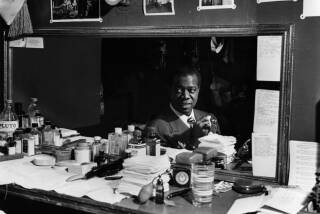Leaving art out of history
How did George Gershwin’s “Rhapsody in Blue” reflect both the Jewish and African American experience in America? Why was Ernest Hemingway’s “The Sun Also Rises” so influential for modern fiction and journalism? What was Abstract Expressionism, and why did Jackson Pollock become a cultural hero for many Americans in the 1950s? How did Marlon Brando’s performance as Stanley Kowalski in “A Streetcar Named Desire” transform American acting, first on stage and then in the movies?
If you are a college student taking a course in American history, you are unlikely to get the answers to any of these questions. The questions won’t even be posed. Nor will the names of American painters, composers, novelists or filmmakers appear in the lectures or on reading lists. The vast majority of American historians no longer regard American culture as an essential area of study. Instead, what they care about is social history -- the struggles and hard-won accomplishments of women, workers, African Americans, Latinos, Asians and Native Americans in a country often inhospitable to the poor and the powerless.
This disinterest in American cultural and intellectual life is a recent development. From the 1940s until the 1960s, a generation of American historians wrote books and taught courses that emphasized the significance of American artists, writers, musicians and film directors. These historians had personally experienced, as soldiers or visiting professors abroad, the struggles against totalitarianism during World War II and the Cold War. So they were preoccupied with explaining what was distinctive and democratic about the American “mind” or the national “character.” And culture was one of the most persuasive ways of identifying what distinguished the United States from its enemies, whether in Nazi Germany or the Soviet Union.
The next generation of American historians came of age during the Vietnam War, the civil rights and women’s movements, and the immigration from Latin America and Asia. The convulsions of the 1960s forced faculty and students to ask: Whose mind? Whose character? Whose novels or music? The earlier fascination with American art and literature now seemed elitist and oblivious to the historical predicaments of ordinary people. Starting in the 1970s, it became unfashionable for historians to write or teach about America as a community of shared beliefs and values, defined by its artists and intellectuals. The new scholarship concentrated instead on the divisive repercussions of race, class, gender and ethnicity.
We have learned a lot from these revisionist interpretations of American history. We know more today about the inequities in the nation’s past. Yet the fixation with social history has led to a severe case of tunnel vision among American historians, an almost exclusive preoccupation with the exploited and victimized, along with an oppressive orthodoxy about what kinds of courses should be taught and who should be hired at universities.
More important, social history is often too narrowly conceived, so that (especially in an age of globalization) it doesn’t really explore the cultural encounters between the United States and the rest of the world. One of the fields in social history currently in vogue is the “borderlands.” Borderlands could mean an analysis of how American and foreign cultures collide with and alter one another. For most historians, however, borderlands has assumed a limited geographical designation: a study of Latin American (mostly Mexican) immigration to Texas, New Mexico, Arizona and California. This migration has obviously had a significant effect on American politics and society. But such a restrictive focus on a particular region and ethnic group does not encourage a recognition of the broader participation of the United States in the emergence of a global culture.
Of course, if students want to learn more about American culture, they can choose a class in art, film or American literature. But because most universities require courses in American history, the indifference to culture among historians has had devastating consequences for the quality of American education.
Like all professors, historians regularly complain that their students are culturally illiterate -- that they’re familiar with Britney Spears and Paris Hilton, but not with Charlie Chaplin, Aaron Copland, Charlie Parker, Arthur Miller or even Marilyn Monroe. Yet this lack of knowledge is not the students’ fault. How can students be expected to have heard of any preeminent American artists and actors if their history professors never mention them in class? Universities are turning out students who can tell you about midwives, sharecroppers and blue-collar workers but not about architects, poets or symphony conductors.
But maybe the situation in our universities, if not in our history departments, is not quite so bleak. For one thing, non-academics (such as Neal Gabler and Richard Schickel) continue to write about the history of American culture. And “presidential” historians (such as Doris Kearns Goodwin and Michael Beschloss) write bestsellers about Abraham Lincoln, Franklin Roosevelt and Lyndon Johnson. Students read the books of these authors. And over the last 10 years, new fields, such as environmental and international history, have become increasingly important as students and the rest of us become more concerned with such problems as global warming and the specter of terrorism.
Meanwhile, students have greater access than any previous generation to the great works of American culture. They can buy, rent or download Sidney Lumet’s 1960 television production of “The Iceman Cometh,” with Jason Robards and a very young Robert Redford. They can see Dustin Hoffman in 1985 as Willy Loman in “Death of a Salesman.” They can learn something about Gershwin’s blending of the minor chords in the songs of Jewish cantors with the blues of African American jazz by viewing the films of Fred Astaire and Gene Kelly, or about Parker’s life and music by watching Clint Eastwood’s “Bird.” And they can grasp why Brando became a revolutionary actor as well as a cultural icon by watching “A Streetcar Named Desire” and “On the Waterfront.”
Whether students take advantage of these opportunities is uncertain. But if some of them do, they may figure out for themselves why American culture still matters not only to those of us who grew up admiring Pollock, Orson Welles and Saul Bellow but to people all over the world who are affected every day by American movies, music and literature.
Richard Pells is a professor of history at the University of Texas at Austin. His books include “Not Like Us: How Europeans Have Loved, Hated and Transformed American Culture Since World War II.” A longer version of this article appeared in the Chronicle of Higher Education.
More to Read
A cure for the common opinion
Get thought-provoking perspectives with our weekly newsletter.
You may occasionally receive promotional content from the Los Angeles Times.










